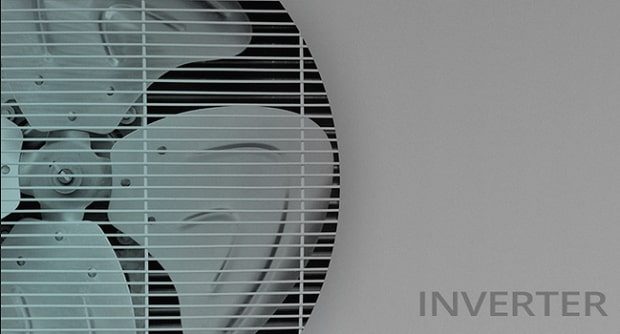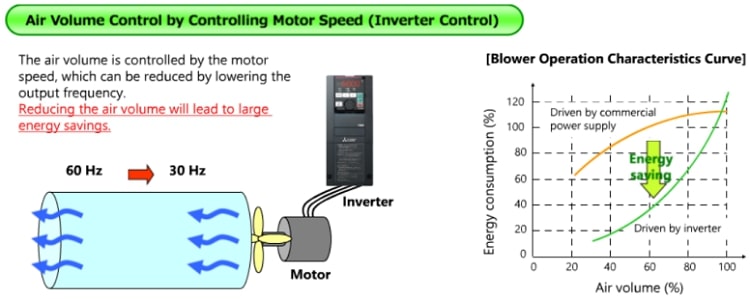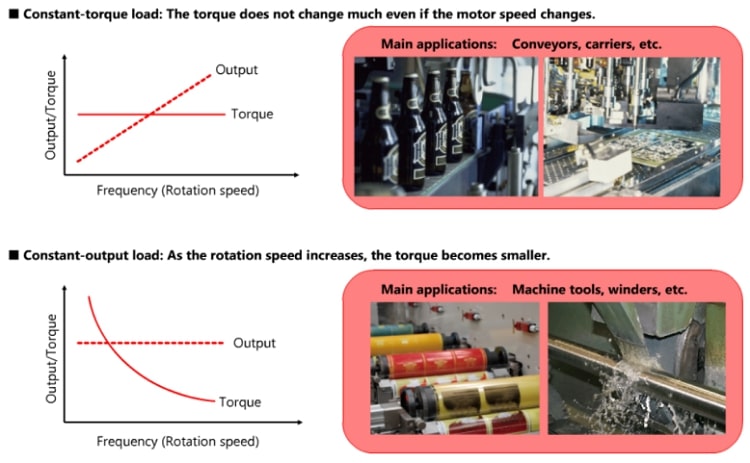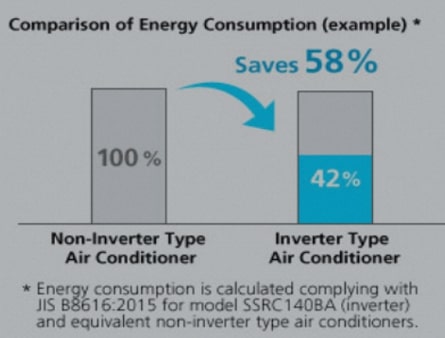What is Inverter Technology? Learn Inverter Technology on electrical appliances
Most of the promotional videos about electronic devices and household appliances such as refrigerators, washing machines, air conditioners, etc. of big companies such as Hitachi, Samsung, Sharp, LG, etc., mention energy saving technology. Inverter.
Inverter helps air conditioners, refrigerators . save more electricity. So what is an inverter, and is it really effective in saving electricity as advertised?
Let me tell you a little bit that Inverter technology needs a 'mosfet' to make it a reality. And modern laptops, PCs or electronic devices all need advanced mosfets for outstanding processing performance.

#first. Types of power sources commonly used in homes
The first type is a DC power source (still often referred to as direct current - DC). The phone battery that you are using, or the power source taken from the solar panel are two specific examples for you to use easily.
This power source is mainly used for small digital devices.
The second is AC power, (still commonly known as alternating current) it is supplied from the electrical outlets in your home and it can power large power devices from a few dozen to several. thousand Watt.

All types of power sources have their own certain uses and limitations, depending on the needs of use, we need to switch back and forth to optimize their use.
Inverter is also known as inverter - device that converts direct current into alternating current.
If you use an oscilloscope to look at the signals of these two sources, you will see, the DC current is always at its maximum voltage value => the waveform is just a straight line, that's also the reason. why is it called direct current?
Alternating current has a sine waveform, representing the voltage change between two peaks in the positive and negative half in one cycle. The reason is simply that the alternating current constantly reverses its direction of travel.
So: Inverter is simply a converter from DC power to AC power. That's it guys!

#2. Example of inverter operation
I would like to give an example of a simple circuit: A DC power supply is used to supply AC power to a light bulb.
We will use 4 switches, to perform the task of converting DC power to AC power, these switches are coupled so that when switches 2 and 3 open, switches 1 and 4 will close. again
And vice versa, when switches 2 and 3 close, switches 1 and 4 will open => which means forcing current to flow through the bulb in 2 different directions similar to alternating current.
The bulb can therefore be seen as being supplied with AC power, even though it is from a DC power source!
When switches 2 and 3 close, switches 1 and 4 open => current flows through the bulb from right to left. When switches 1 and 4 are closed, switches 2 and 3 are open => current flows through the light bulb in the left to right direction.
You can see that even though it is using DC power, the light bulb is still being supplied with a current ~ alternating current.
However, turning on / off the switch suddenly will not create a sine waveform as I described above, but only in the form of a square wave.

The sharp peaks of square waves can reduce the life of electrical equipment, so this square peak must be smoothed before it can be used in practice.
Going back to the simple circuit above, you can think of the light bulb in this example ~ the light bulb in your house.
The power source in your house has a frequency of 50 or 60Hz => the current flowing through the light bulb will change direction 50/60 times per second, this change of direction is too fast for us to turn on / off the manual switches normally. to produce 50 or 60 Hz alternating current.
To achieve such a fast on/off switch, engineers will use special and complex electronic components such as IGBT, MosFet.
To be able to change the frequency of the AC power at the output of an inverter, the controller only needs to change the number of times the electronic switches open/close in each second.
Therefore, to reduce the frequency of AC power, it is necessary to reduce the number of times the switches open/close per second. Conversely, if you want to increase the frequency of the AC power, you must increase the number of times the switches open/close each second.
#3. How does inverter technology in air conditioners work?
The most common application of inverters is in air conditioners – air conditioners that are being used in your home.
The AC power will be passed through the 'regulator' to convert to DC power. Then this DC power will go through the Inverter => become an AC source with an adjustable sine waveform frequency.
I will explain a little bit about how the air conditioner works, so that it is easier for you to understand what I will say in the content below:
The structure of the air conditioner consists of: HOT ELECTRIC (installed outside) and CONDITIONER (installed in the room).
The most important part of the air conditioner is the copper pipe system (no gas inside) => this copper pipe system will lead the gas to run from the hot unit to the cold unit in a cyclic manner. Think of it like a human blood vessel.
In this copper pipe system will be fitted with a VALVE (the refrigerant gas - GA will be reduced from high pressure to low pressure) and => passes through the indoor unit (1) => the gas continues to pass through the system. COMPRESSOR system (compresses low pressure gas to high pressure) => then runs through the HOT BOARD. It just keeps running around like that.
(1)Gas after being cooled from the EXTRA VALVE will pass through the CONDITIONER => the air fan will blow cold air around the copper pipe into the room => and the room will gradually cool down.
=> In short, the air conditioner consumes the most electricity, especially in the COMPRESSOR, and the inverter technology is born to interfere with this COMPACT.
With air conditioners without inverter technology, when you set the temperature on the controller to 20 degrees Celsius, the compressor of the air conditioner will always run at maximum capacity until the room temperature = 20 degrees Celsius.

When 20 degrees Celsius has been reached, the compressor will automatically turn off, after a period of stopping, the outside ambient temperature will increase the room temperature.
When the temperature difference with the temperature is set from 1 => 2 degrees Celsius, the compressor will automatically run again and still with the maximum capacity until it reaches 20 degrees Celsius, then it stops again.
As you have seen, in air conditioners without inverter, the compressor only works in 2 on/off modes, always running at maximum capacity. Power consumption for each machine restart from the beginning is very expensive !
For air conditioners with inverters, the cooling compressor capacity increases gradually until the set temperature is reached (instead of always running at full capacity like without the inverter).
After reaching the desired temperature, the inverter will automatically reduce the frequency of the AC power supply to the compressor => reduce the compressor speed, not turn off the compressor completely.

Therefore, air conditioners with Inverter will run steadily at low capacity => reduce power loss when not having to restart the compressor continuously.
When using ~8 hours/day, the power consumption of an inverter air conditioner can be reduced from 30 to 60% compared to a non-inverter air conditioner, it is indeed a good friend of your electricity bill!
Hope this article will be useful to you, wish you all stay cool on hot days
You should read it
- Learn about energy saving technologies on air conditioners
- Compare to decide whether to buy inverter air conditioner or conventional air conditioner
- Top 5 best washing machine models 2021
- Why is conventional air conditioner more popular than Inverter?
- How does sunlight become solar energy?
- How to use air conditioner control, Aqua air conditioner accurately, save electricity
 5 Reasons You Need Indoor Air Purifiers
5 Reasons You Need Indoor Air Purifiers Review 3 best air purifiers today
Review 3 best air purifiers today Tips for saving electricity when using the refrigerator: Simple but effective
Tips for saving electricity when using the refrigerator: Simple but effective What is MicroLED? What's different from OLED? How is the application?
What is MicroLED? What's different from OLED? How is the application? Common error codes of induction cookers
Common error codes of induction cookers Do you really know how to use the fridge? Answer these questions to know the truth
Do you really know how to use the fridge? Answer these questions to know the truth